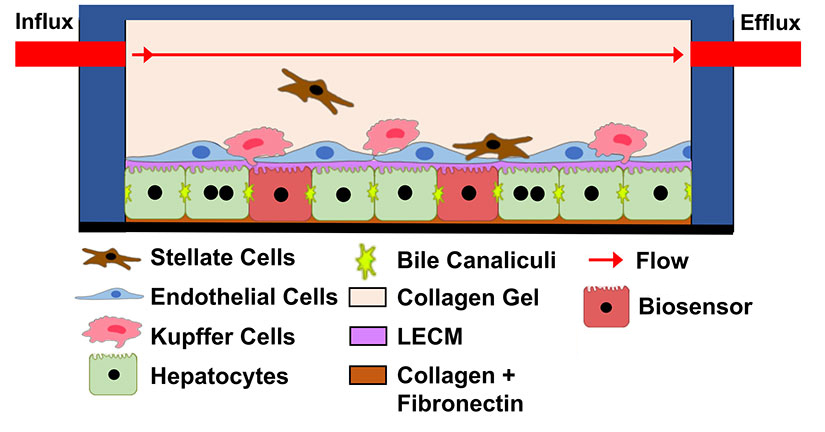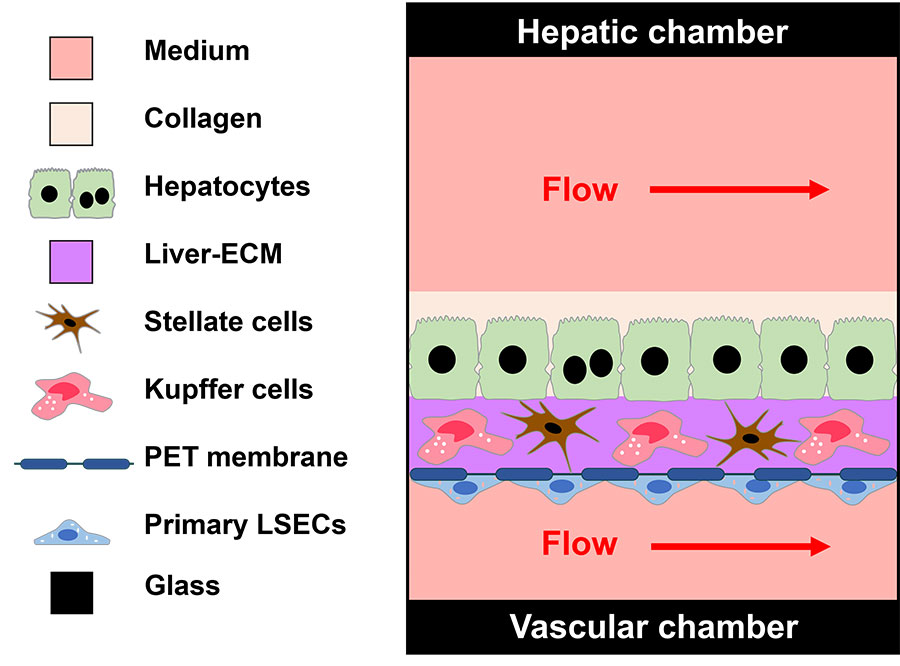Liver MPS Platforms
Liver Acinus Microphysiology Systems
(LAMPS)

Overview of the LAMPS model setup and key features
-
The liver acinus microphysiological system (LAMPS) is a structured biomimetic, that is a 3D layered model constructed through a combination of sequential cell layering and cell-to-cell self-organization using hepatocytes followed by the addition of non-parenchymal cells (NPCs) including primary liver sinusoidal endothelial cells (LSECs), hepatic stellate cells (HSCs), and Kupffer cells, and is maintained under flow to mimic either Zone 1 or Zone 3 oxygen tensions.
-
LAMPS can be constructed with both primary liver cells and patient-derived liver induced pluripotent stem cells (iPSCs).
-
The LAMPS has been used in ADME-Tox studies, as a tool to demonstrate metabolic dysfunction-associated steatotic liver disease (MASLD) progression, to test the safety and efficacy of computationally predicted MASLD drugs, and as a precision medicine platform to characterize genotype-specific differences in MASLD progression and response to drug treatment to aid in clinical trial cohort selection.
-
The LAMPS has been tested and reproduced by the Texas A&M Tissue Chip Validation Center (Tex-Val), one of the National Center for Advancing Translational Sciences (NCATS) funded Tissue Chip Testing Centers (TCTC) and has demonstrated reproducible features for hepatic function.
Vascularized Liver Acinus Microphysiology Systems
(vLAMPS)

Overview of the vLAMPS model setup and key features
-
The vascularized liver acinus microphysiological system (vLAMPS) is a structured biomimetic, composed of a vascular chamber consisting of primary liver sinusoidal endothelial cells (LSECs), and a 3D layered acinus that mimics the Space of Disse through a liver specific hydrogel that hosts non-parenchymal cells (NPCs) such as hepatic stellate cells (HSCs), and Kupffer cells, with hepatocytes on top of the same liver specific microenvironment and a collagen rich overlay.
-
When placed under flow the system can mimic the gradual oxygen tensions (Zone 1 through Zone 3) of the sinus, replicating the metabolic zonation of the acinus.
-
The vLAMPS can be constructed with both primary liver cells and patient-derived liver induced pluripotent stem cells (iPSCs).
-
The vLAMPS has been used as a tool to demonstrate metabolic dysfunction-associated steatotic liver disease (MASLD) progression, including but not limited to the onset of insulin resistance, fibrosis, and inflammatory processes.
-
The parallel compartmentalized chambers permit diverse flow configuration and coupling. For example, the vLAMPS can be coupled to a pancreatic islet MPS to replicate the liver-pancreas axis to study the correlation between MASLD to type 2 diabetes mellitus (T2DM) progression.
-
Additionally, the vascular chamber allows infusion of drugs of interest and “circulating” factors through a more biomimetic flow.
-
The device is fabricated exclusively in glass, which minimizes drug/biologics binding to the device for optimal for drug testing.

